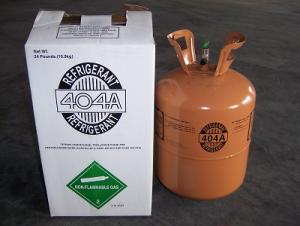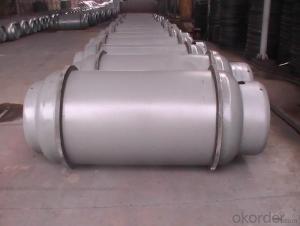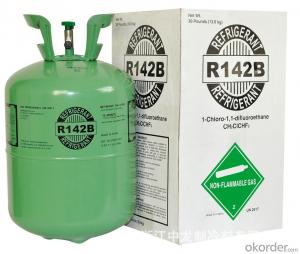Blend Refrigerant R410a Gas
- Loading Port:
- Ningbo
- Payment Terms:
- TT OR LC
- Min Order Qty:
- -
- Supply Capability:
- 1000MT m.t./month
OKorder Service Pledge
Quality Product, Order Online Tracking, Timely Delivery
OKorder Financial Service
Credit Rating, Credit Services, Credit Purchasing
You Might Also Like
R410A is widely chosen as leading high-pressure alternative to R22 for new air-conditioning system.
Refrigerant Specification:
| Property of chloride : |
| ||||||||||||||||
| Packing | Disposable cylinder 25lb/11.3kg; Recyclable cylinder 926L; ISO-Tank. | ||||||||||||||||
| |||||||||||||||||
| Quality standard : |
| ||||||||||||||||
- Q: Ionic compounds, covalent compounds, electrolytes, non-electrolytes, which are both compounds and inorganic compounds
- They are different concepts -
- Q: Compare the difference between London smoke and Los Angeles photochemical smog
- Los Angeles photochemical smog nitrogen content and hydrocarbons and derivatives more, mainly close to the car exhaust. Foggy London situation related to coal, soot solid particles and sulfur oxide more. Foggy London is more bleak, and Los Angeles is more toxic.
- Q: What is the hydrocarbon thing
- Hydrocarbon, which is composed of two elements, consists of carbon and hydrogen. It is called a hydrocarbon and a hydrocarbon, which reacts with chlorine, bromine vapor, oxygen and so on. It does not react with strong acid, strong base, strong oxidizer (Such as: potassium permanganate) reaction, such as methane and chlorine in the light conditions of reaction to produce methyl chloride, dichloromethane, chloroform (chloroform) and tetrachloromethane (carbon tetrachloride) and other derivatives in the Hydrocarbon molecules in the carbon atoms connected to each other to form a carbon chain or carbon ring molecular skeleton, a certain number of hydrogen atoms attached to the carbon atoms, so that each carbon atom to maintain the price of the type of hydrocarbon is very much, the structure of known hydrocarbons More than 2,000 hydrocarbons are the parent of an organic compound. Other organic compounds can be seen as derivatives of one or more hydrogen atoms in the hydrocarbon molecule that are replaced by atoms or radicals of other elements. Word, is the use of "carbon" consonant with "hydrogen" vowel synthesis of a word, with "carbon" and "hydrogen" the composition of the internal structure of the word, the hydrocarbon is the parent of all organic compounds can be said that all Organic compounds are nothing but the result of replacing some of the atoms in the hydrocarbons with other atoms.
- Q: Are the asphalt and peat kinds of vegetables have heavy metal?
- Asphalt is composed of different molecular weight hydrocarbons and non-metallic derivatives of dark brown complex mixture, is a high viscosity organic liquid, was liquid, the surface was black, soluble in carbon disulfide. Asphalt is a waterproof moisture and corrosion of organic cementitious materials. Asphalt can be divided into coal tar pitch, petroleum asphalt and natural asphalt three: Among them, coal tar pitch is a by-product of coking. Petroleum asphalt is the residue after distillation of crude oil. Natural asphalt is stored in the ground, and some of the formation of ore or in the crustal surface accumulation. Asphalt is mainly used for coatings, plastics, rubber and other industries and pavement and so on.
- Q: The functional group of the derivative of the hydrocarbon
- Common functional groups are: carbon-carbon double bond, -OH-COOH-CHO-NH2, often react, replace (including halogenation, nitration, sulfonation, esterification, hydrolysis, etc.), addition, elimination, addition polymerization , Organic matter oxidation and reduction, color and so on.
- Q: What is the difference between organic matter and inorganic matter?
- Organic compounds in addition to a few, can generally burn. Compared with inorganic matter, their thermal stability is relatively poor, the electrolyte is easy to heat decomposition. The melting point of organic matter is low, generally not more than 400 ℃. The polarity of organic matter is very weak, so most of the water is not soluble. The reaction between organic matter, mostly intermolecular reactions, often requires a certain activation energy, so the reaction is slow, often requiring catalyst and other means. And the reaction of organic matter is more complex, under the same conditions, a compound can often be several different reactions at the same time, generate different products.
- Q: Cracked
- It is almost impossible for this problem to look at your reaction conditions. Generally speaking, the alkane reaction is mainly difficult to decompose directly into ions
- Q: Is the oxygen derivative of the hydrocarbon a non-methane total hydrocarbon?
- What is the total hydrocarbon for non-methane? Non-methane total hydrocarbons generally refer to all volatile hydrocarbons other than methane (which are predominantly C2 to C8), abbreviated NMHC
- Q: Is steel not organic synthetic material?
- Steel is a mixture, the vast majority of elemental iron, also contains other elements, carbon is mixed in the inside, and did not constitute a compound.
- Q: What is the aromatic hydrocarbon .. what is the derivative of the aromatic hydrocarbon
- Aromatic hydrocarbons referred to as "aromatic hydrocarbons", refers to the molecule containing benzene ring structure of the hydrocarbons. Is a closed chain.
Send your message to us
Blend Refrigerant R410a Gas
- Loading Port:
- Ningbo
- Payment Terms:
- TT OR LC
- Min Order Qty:
- -
- Supply Capability:
- 1000MT m.t./month
OKorder Service Pledge
Quality Product, Order Online Tracking, Timely Delivery
OKorder Financial Service
Credit Rating, Credit Services, Credit Purchasing
Similar products
Hot products
Hot Searches






















